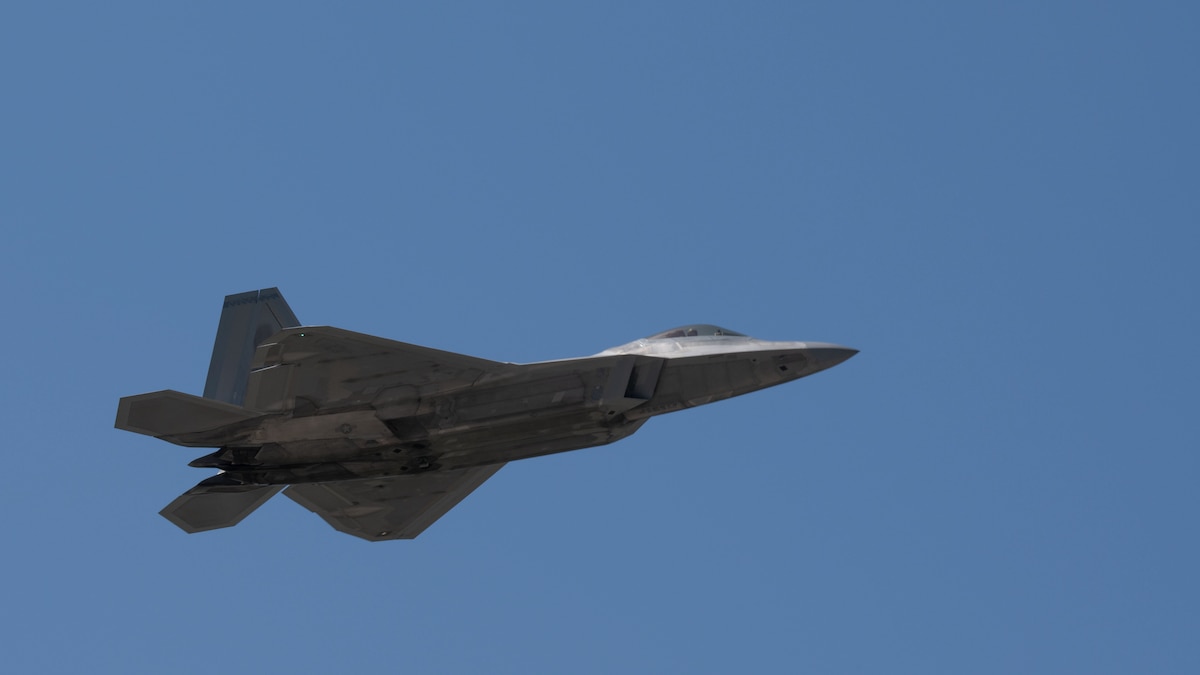In a significant display of military cooperation, a pair of U.S. Air Force F-22 Raptors engaged in a rare dogfighting exercise with South Korean F-35As over the Korean Peninsula on May 16.
India-China Face-Off: PLA Readies High-Altitude Rocket Facility; Indian Army Sets MRO Unit At Dizzying Heights
Pakistan Eyes More J-10C Fighters; Continues To “Lead” Indian Air Force In Combat Jet Acquisition Since 1954
The exercise, which marked the first simulated air battle between these advanced fighter jets of the two nations, featured close-range air combat maneuvers designed to test and enhance the capabilities of both air forces, according to the South Korea-based Maeil Business Newspaper.
The Republic of Korea Air Force (ROKAF) confirmed that the training involved the four stealth fighters taking turns in offensive and defensive roles during simulated confrontation scenarios.
The maneuvers allowed pilots to share the latest tactics and improve their skills in identifying and engaging enemy aircraft at close range.
The joint exercise followed the arrival of several U.S. Air Force F-22s at Gunsan Air Base on May 13, as announced by the U.S. Department of Defense via the Defense Image Information Distribution Service (DVIDS).

The F-22s belong to the 19th and 199th fighter squadrons, underscoring the strategic importance of the deployment. The Department of Defense stated, “The Raptor’s visit to Korea demonstrates the capability of the US Pacific Air Force to deploy power at various strategic points to strengthen command and control in the Indo-Pacific region.”
The 8th Fighter Wing at Kunsan Air Base, which is hosting the F-22s, said that the base would support maintenance and deployment of the jets throughout the next week.
It remains to be seen if the Raptors participate in additional joint drills during South Korea’s biennial training starting on May 17. This training will feature a mix of ROKAF’s F-35As, F-15Ks, F-16s, and FA-50s.
The deployment of the F-22s marked their first public return to Korea since the Seoul International Aerospace and Defense Industry Exhibition (ADEX) in October last year.
The 8th Fighter Wing highlighted that the F-22s would help test Agile Combat Employment (ACE) capabilities in the Indo-Pacific region.
Air Force leaders have emphasized ACE as a crucial component in the pivot towards great power competition, particularly with China. ACE involves small teams of airmen and aircraft operating from remote or austere bases, allowing for rapid movement and deployment. The U.S. Air Force has been intensifying ACE training, with the F-22s playing a significant role in the strategy.
The Powerhouses of Modern Air Combat: F-35 vs F-22
The F-35 and F-22 are categorized as fifth-generation fighters, known for their stealth capabilities and advanced aviation electronics, making them the most formidable jets in the world.
During the latest exercise, the South Korean Air Force, maintaining professional discretion, did not disclose the outcome of the training exercise. Typically, such results are discussed privately during post-sortie debriefings among the participants.
The F-35 Lightning II, a single-seat, single-engine, stealth multirole fighter jet, excels in ground attacks and air defense missions. In contrast, the F-22 Raptor, a single-seat, twin-engine fighter, specializes in air dominance.
Despite its older design, the F-22 remains a critical asset, though it is slated to be replaced by the Next-Generation Air Dominance Fighter (NGAD). Unlike the F-22, which is banned from foreign military sales, the F-35 has gained significant traction in the export market, with numerous international partners and buyers.
The widespread use of the F-35 among U.S. allies has highlighted its advanced capabilities compared to previous-generation fighter jets. However, many air forces have not fully tested the F-35’s prowess in aerial dogfights. The F-22, however, is one aircraft that can truly challenge the F-35.
In 2018, two U.S. Air Force F-22 Raptors squared off against two Royal Norwegian Air Force F-35s in a one-day training exercise. A Norwegian F-35 pilot noted that training with the F-22s provided valuable opportunities that would not usually be available, as the F-35s often “overpower” conventional non-stealth aircraft.
The F-35 was not intended to match the F-22 in air superiority. The F-22 was developed as a high-end air superiority fighter, while the F-35 was primarily designed as an air-to-ground strike aircraft with self-defense capabilities.
Dr. Brent M. Eastwood, an emerging threats expert and former U.S. Army Infantry officer, highlighted the F-22’s speed and maneuverability advantages with National Interest.
“The F-22 is faster than the F-35 – MACH 2.2 versus MACH 1.6 for the Lightning II. The F-22 is 30 percent heavier, but it may be more maneuverable due to its Pratt & Whitney F119 engines providing more thrust (70,000 pounds) than the single Pratt & Whitney F-135 engine on the F-35. The F119 engine’s thrust vectoring also may give the Raptor an edge in aerial combat with a higher thrust-to-weight ratio,” Eastwood said.
Despite these differences, the F-35 is designed for modern warfare. David Berke, a retired Marine Corps officer and experienced pilot of the F-22 and F-35, regards the F-35 as a milestone in aerial combat.
He emphasized its role as a sensor in the battlespace and as a “quarterback” for other systems. The F-35 boasts unparalleled decision-making capabilities, both airborne and on the ground.
The F-35, a formidable stealth machine, operates where enemies least expect it to. Coupled with its anti-access aerial denial features, the aircraft can perform its best in hostile environments. This versatility and advanced technology emphasize its importance in the U.S. military and among its allies.
- Contact the author at ashishmichel(at)gmail.com
- Follow EurAsian Times on Google News